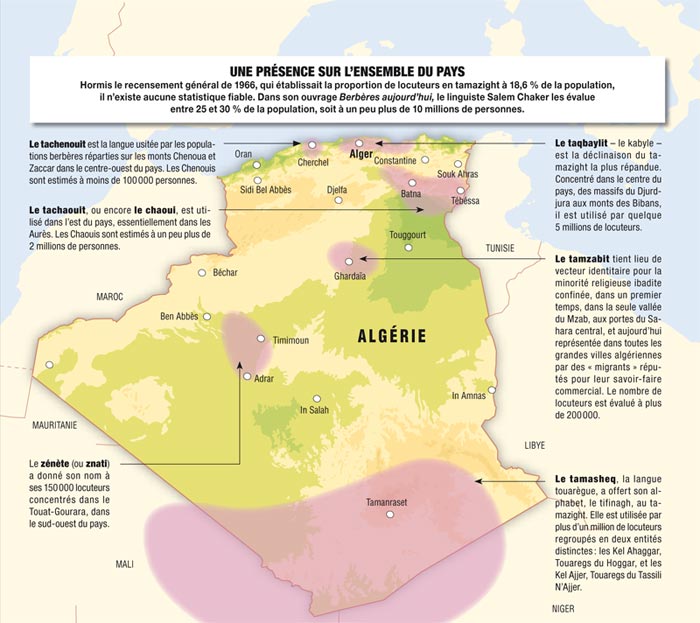According to El Bilad, the Communications Head for the Upper House of Parliament and director-general of Algerian television Salim Rabahi has decided to diversify language in news. A channel is launching three daily news schedules in different Amazigh languages to solve the lack of linguistic diversity in public television, starting with a news summary at 4 p.m., followed by a news bulletin at 6 p.m., and another news segment by midnight.
“Tamazight,” the pluralistic Amazigh language bloc, became official under the 2016 Constitution, and the State has since started to develop the necessary mechanisms for its teaching. One of the things that provoked discussion was the standardization of a single Amazigh language. Algeria has more than four Amazigh-speaking groups, not just Taqbaylit, which has been at the forefront of many initiatives.
Daika Dridi wrote about this in HuffPost Algérie, “What neither Benghabrit nor Ouyahia say is that the students who are taught “Tamazight” everywhere in Algeria and including Kabylia are fleeing the courses of this teaching because they do not understand what is taught, because they do not recognize this language which is supposed to be their mother tongue. It is not really the Berber languages as they are spoken by their communities that the schoolchildren of Kabylia, Mzab, the Shawi or Targi regions learn when they go to “Tamazight” class but something else.”
Abderrezak Dourari, who heads a state center for research and reflection on the teaching of Tamazight (National Pedagogical and Linguistic Center for Teaching Tamazight), talks about this pedagogical failure which, he says, is the same failure in Morocco, explaining that mistakes made with Arabization have been repeated with the teaching of Tamazight, which has become a “Re-Berberization” enterprise.
“What is the usefulness of this artificial language apart from flattering our ego? It has no chance of survival and it is this language that is taught at school,” says Abderrezak Dourari.
What began as a brilliant political victory with the enshrinement of Amazigh language teaching in the Algerian constitution has turned into a language that nobody understands, including those who created it. Dourari explains that it was political authorities like the High Commission for Amazighity (HCA) and not linguists who invented this language.
In reality, texts in “Tamazight” (official documents, advertising posters, etc.) never exist initially as “texts in an Amazigh language,” they are always translations of French or Arabic, acrobatically elaborated transcriptions using the Mammeri lexicon. Abderrezak Dourari regrets that the plural aspect of the Amazigh language bloc has been completely embroiled in a process of unification without any real reflection. The only linguistic plurality that seems to stay intact is the choice of script. This isn’t dictated by the Ministry of Education which ensures the presence of the three alphabets (Arabic, Tifinagh/neo-Tifinagh and Latin) in textbooks, leaving room for teachers to decide. This cannot be said for Morocco where IRCAM, a non-democratic body, has imposed the sole use of neo-Tifinagh. The first major network for Amazigh language teaching in Morocco was created in Rabat by a group from the Souss on November 10, 1966 (AMREC) whose action primarily targeted oral culture and literacy because of the repressive context at the time.
It is the role of an Amazigh Language Academy to preserve the plurality of Algerian Amazigh languages by taking them from those who speak them and collecting corpora for each of its varieties, so that they are taught in an effective way. This has not yet emerged. Abdelwahab Sahrawi, a specialist in Arabic and Islamic studies, said efforts should be focused on deepening academic research, before suggesting a common transcription between variants of the Amazigh language within the range of Shawi, Kabyle, Tamahaq, Tamzabt and Shelhi expression, knowing that some are concerned about consolidating the cohesion of the Algerian people.
The president of the “Culture and Reform of the Old Qsar” association in Ouargla, Hocine Boughaba, for his part, discussed the means of preservation and promotion of the Amazigh heritage and its variants.
Mr. Boughaba said that the association has been, since its creation, a cell composed of researchers, academics and poets, responsible for the enrichment of research in the field of the Wargli-Zenatic linguistic variant.
For those interested in excellent linguistic work on Amazigh varieties check out: Salem Chaker, Lameen Souag, Amina Mettouchi, Marijn van Putten, and Maarten Kossmann.

